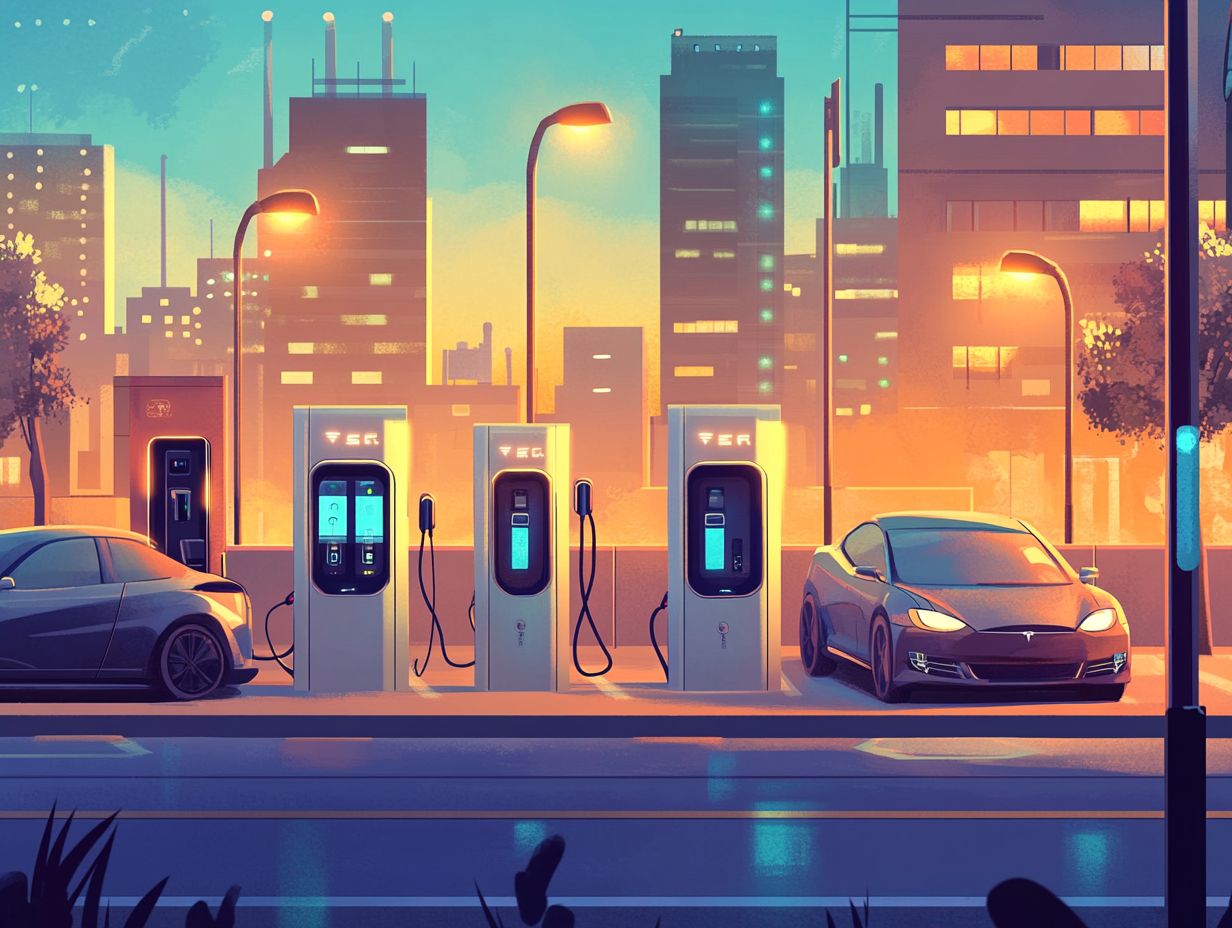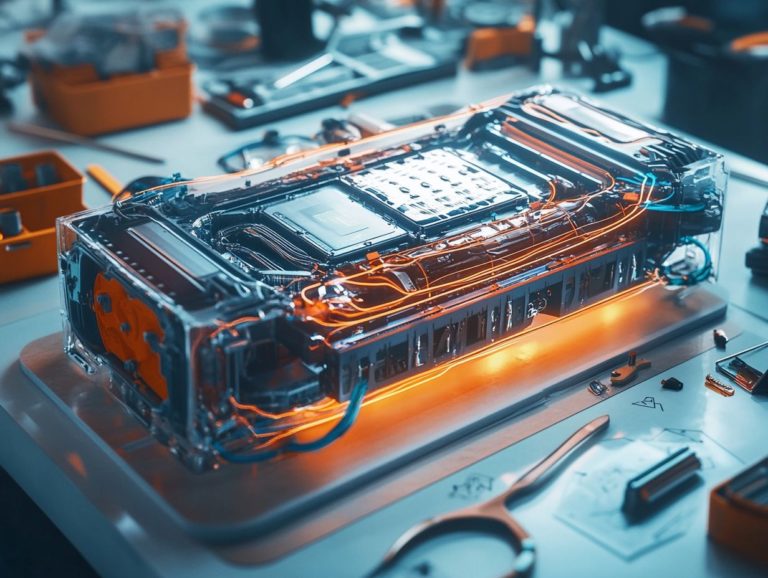What Are the Different Types of EV Charging?
Electric vehicles (EVs) are becoming more popular. Understanding the different charging methods is crucial for current and future owners like you.
Let’s dive into the various types of EV charging available today, ranging from Level 1 to DC Fast Charging and even cutting-edge wireless options.
Each section provides a comprehensive overview, complete with pros and cons to empower you to make informed decisions.
You’ll explore important factors such as cost, convenience, and availability, ensuring you’re fully prepared for your EV journey.
Contents
Key Takeaways:

- Level 1 charging is slow but affordable, taking 8-12 hours.
- Level 2 charging is faster, needing 4-6 hours, but costs more to install.
- DC fast charging is quick, taking only 20-30 minutes, but is expensive and not all EVs can use it.
What is EV Charging?
EV charging is all about replenishing the battery of electric vehicles (EVs). It involves various methods and technologies, including Level 1 charging, Level 2 charging, and DC fast charging. As electric vehicle popularity surges across the United States, understanding these charging solutions is essential for you as an EV owner and for those developing the charging infrastructure.
The BIPARTISAN Infrastructure Law emphasizes the need for robust charging networks in public spaces. This ensures that electricity demand matches the increasing needs of electric vehicle technology.
Among these methods, Level 1 charging is your go-to option, utilizing a standard household outlet. It s perfect for overnight recharges, offering convenience for your daily commutes. Conversely, Level 2 charging, found at public stations and in homes, delivers faster replenishment for when you need to charge during quick stops.
If you re embarking on a longer journey, DC fast charging is your best friend. It provides rapid energy boosts that allow you to recharge your EV in as little as 30 minutes.
The integration of various charging protocols and connector types plays a significant role in influencing charging efficiency. For instance, the J1772 standard is used for Level 2 charging, while CCS or CHAdeMO is typical for DC fast charging. Understanding these technologies is crucial, as they cater to different travel patterns and charging needs, ultimately paving the way for the broader adoption of electric vehicles.
Level 1 Charging
Level 1 charging is one of the most straightforward methods for powering your electric vehicle. By simply using a standard household outlet, it becomes an accessible solution for home charging, seamlessly fitting into your everyday routine.
Overview of Level 1 Charging
Level 1 charging employs a standard 120-volt outlet to charge electric vehicles. This method typically provides around 4-5 miles of range per hour, making it ideal for overnight charging when you can plug in your vehicle at the end of the day.
While it may be the slowest charging option available, it serves as a practical choice for those with shorter daily commutes or those fortunate enough to park close to an outlet. Compared to Level 2 or DC fast charging options, which require more advanced infrastructure and can recharge vehicles in hours or minutes, Level 1 charging’s simplicity is particularly accessible for anyone beginning their electric vehicle journey.
As a potential electric vehicle owner, it’s essential to consider your lifestyle and driving habits. These factors will significantly impact whether Level 1 charging meets your needs effectively.
Pros and Cons
Level 1 charging brings a blend of benefits to the table, such as low installation costs and great convenience for EV owners. However, it also presents certain drawbacks, notably longer charging times when compared to Level 2 and DC fast charging options.
While the affordability of Level 1 charging equipment makes it an appealing choice, especially for those who charge their vehicles overnight at home, the markedly slower charging rate can pose challenges for those who need a quicker turnaround.
The ease of accessing standard outlets allows almost anyone to set up a Level 1 charger without needing specialized infrastructure. However, for individuals who embark on longer trips or maintain a demanding driving schedule, relying solely on Level 1 charging may turn out to be less efficient, potentially leading to disruptions in their daily routines.
Level 2 charging gives you awesome benefits, including significantly reduced charging times and enhanced convenience. However, it does come with higher installation costs and may necessitate specific charging setup.
This method allows you to recharge your electric vehicle in just a few hours. Imagine the convenience of having a Level 2 charger at home your day-to-day experience would be vastly improved, minimizing downtime and enabling swift trips.
However, you may need to spend more upfront, especially if you need electrical upgrades to meet the higher power demand. This might lead you to weigh the costs against the benefits and consider alternative charging solutions, like DC fast charging stations.
Level 2 Charging

Level 2 charging markedly accelerates the faster charging speed for electric vehicles, making it the preferred option for both home and public charging stations.
This makes charging faster and easier, ensuring that you have a reliable and efficient way to keep your vehicle powered up.
Overview of Level 2 Charging
Level 2 charging utilizes a 240-volt outlet, allowing for a significantly faster charging experience for electric vehicles compared to Level 1 or home charging options. This makes it an essential component of effective charging setup.
With this technology, you can drastically reduce charging time, often replenishing your vehicle’s battery within just a few hours. If you drive an electric vehicle, setting up a Level 2 charger typically requires a special power line just for your charger and a compatible charging station, which can be conveniently installed at home or accessed at public charging locations.
The operational efficiency of Level 2 chargers accommodates a variety of EV models, presenting a more robust solution for your everyday charging needs. Ultimately, this enhances convenience for you while also fostering a more favorable environment for the adoption and integration of electric vehicles into your daily routine.
DC Fast Charging
DC fast charging stands as the apex of EV charging technology, allowing for swift recharging of electric vehicle batteries at public charging stations. This capability is essential for long-distance travel and plays a vital role in fostering broader acceptance of electric vehicles in the market.
Overview of DC Fast Charging
DC fast charging harnesses high voltage typically 400 volts and above to significantly reduce charging times, making it a crucial element of EV charging networks at many public charging stations.
This method not only speeds up the replenishment of your electric vehicle s battery but also enables you to plan your journeys with minimal downtime. The technology has rapidly advanced, enhancing compatibility with a diverse array of electric vehicle models, from mainstream brands to luxury manufacturers.
Using common connectors like CCS and CHAdeMO makes it easy for lots of cars to take full advantage of its swift charging capabilities. The efficiency metrics, including power output and energy transfer rates, showcase impressive progress in the pursuit of sustainable mobility, helping to shape the future of charging setup in both urban and rural settings.
Pros and Cons

DC fast charging offers amazing convenience and cuts down charging times significantly. However, it often comes with higher costs for installation and operation, which can be a hurdle in some areas.
This technology shines for long-distance travelers and fleet operators who need quick turnaround times to optimize efficiency. However, the initial investment in infrastructure might discourage smaller businesses or those in rural areas from making the leap. You ll likely appreciate how swiftly your vehicle can be replenished, significantly minimizing downtime.
Yet, it’s essential to keep an eye on potential spikes in energy costs during peak demand periods. Striking the right balance among these considerations is vital for anyone aiming to encourage electric vehicle adoption while navigating the complexities of DC fast charging solutions.
Wireless Charging
Wireless charging, often referred to as inductive charging, represents an innovative advancement designed to streamline the EV charging experience. By eliminating bulky cables and plugs, this amazing technology makes charging your EV incredibly easy!
Overview of Wireless Charging
Wireless charging harnesses electromagnetic fields (invisible forces that can transfer energy) to transfer energy between two coils. This allows you, as an EV owner, to charge your vehicle without the hassle of plugging in. This is a significant step forward in charging solutions.
This innovative approach not only enhances your convenience but also integrates seamlessly with the expanding infrastructure for electric vehicles. Its efficiency is impressive, ensuring that a substantial amount of energy is transferred with minimal waste, making it a compelling alternative to traditional wired charging methods.
As more EV manufacturers embrace this technology, compatibility becomes increasingly important. It ensures that you can conveniently use various wireless charging stations. The evolution of this technology signifies not just a transformation in how energy is delivered, but also plays a crucial role in fostering a more sustainable future for transportation.
Pros and Cons
Wireless charging provides you with exceptional convenience and ease of use as an electric vehicle owner. However, it does come with its own set of challenges, particularly concerning cost, efficiency, and how readily it can fit into the existing charging infrastructure.
As you look for seamless solutions to power your vehicle, the idea of simply parking over a charging pad becomes increasingly tempting. However, while this technology offers a hassle-free experience, you need to weigh the initial expenses of setting up such systems against the reliability of traditional plug-in charging methods.
The efficiency of wireless charging can vary, often resulting in longer charging times and energy losses that may not sit well with those who prioritize quick refueling. It’s crucial for you to balance these pros and cons as you contemplate the transition to wireless options.
Factors to Consider When Choosing an EV Charging Method
When you evaluate EV charging methods, it’s essential to consider key factors like cost, convenience, and charging time. This approach ensures that your choice aligns perfectly with your unique needs and driving habits.
Cost, Convenience, and Availability

Cost, convenience, and availability are crucial when choosing the best EV charging options for your home and public needs.
These factors significantly impact your choices as an electric vehicle owner. Installation costs, for example, vary based on required electrical upgrades and the type of charger selected.
Charging stations should be easy to use, whether at home or in public. This ease enhances your driving experience, allowing you to recharge your vehicle with no hassle.
Location accessibility is also vital. Imagine having charging stations just around the corner! This convenience makes owning an electric vehicle a breeze.
Frequently Asked Questions
What are the different types of EV charging?
There are three main types: level 1, level 2, and DC fast charging. Each type serves different needs.
What is level 1 EV charging?
Level 1 EV charging is the slowest type of charging, using a standard 120V outlet to charge the vehicle’s battery.
What is level 2 EV charging?
Level 2 EV charging uses a 240V outlet and is faster than level 1 charging, making it a popular choice for both home and public charging stations.
What is DC fast charging?
DC fast charging, also known as level 3 charging, quickly recharges your car in about 30 minutes, making it the fastest type of EV charging.
Do all EVs support all types of charging?
No, not all EVs support all types of charging. Some may only support level 1 and 2 charging, while others may also support DC fast charging. It’s important to check your vehicle’s specifications before choosing a charging method.
Are there different types of charging connectors for EVs?
Yes, there are different types of charging connectors for EVs, depending on the type of charging method. Level 1 and level 2 charging typically use a J1772 connector, while DC fast charging uses a CHAdeMO or CCS connector.






